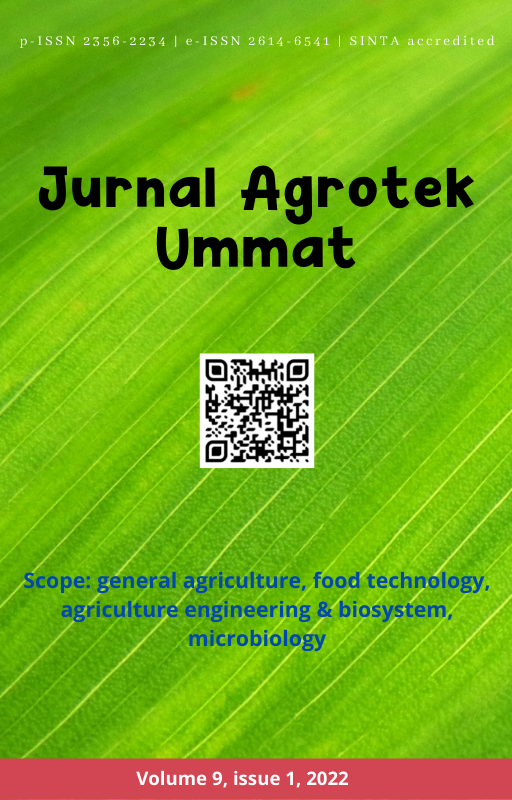The effectiveness of several varieties and mycorrhizal fertilizers on the yield of sweet corn (Zea mays saccharata sturt)
DOI:
https://doi.org/10.31764/jau.v9i1.6662Keywords:
corn yield, mycorhiza fertilizer, sweet corn varietiesAbstract
This study aims to determine the best variety and dosage of mycorrhizal fertilizer to the yield of sweet corn (Zea mays saccharata Sturt.). This research was conducted on farmer’s land in Dusun Beringin Makmur I, Kecamatan Rawas Ilir, South Musi Rawas Regency, South Sumatra, from October to December 2020. This study used an experimental method with a split plot design consisting of 9 treatment combinations and 3 replications. The first factor (Main-plot) of variety (V), namely V1 = Talenta; V2 = Bonaza; V3 = Master Sweet, while the second factor (Sub-plot) is mycorrhiza fertilizer (M), namely M0 = without mycorrhiza fertilizer; M1 = 30 g per plant; M2 = 40 g per plant. Observational in this study included the cob of lenght (cm), cob of diameters (cm), cob of weight per plant (g) and cob of weight per plot (kg). The results showed that Bonanza variety gave the best yield on sweet corn, 40 g mycorrhizal fertilizer per plant gave the best yield on sweet corn and tabulated combination of variety and mycorhiza fertilizer 40 g per plant gave the highest yield of sweet corn at 4.22 kg per plot equivalent to 16.88 ton ha-1.
References
Amir, N., & Rosmiah. (2018). RESPON TANAMAN JAGUNG MANIS (Zea mays saccharata Sturt) TERHADAP PUPUK KOMPOS KOTORAN AYAM DAN NPK DENGAN TAKARAN BERBEDA. Klorofil, 13(Desember), 94–98.
Ansyar, I. A., Silvina, F., & Murniati. (2017). PENGARUH PUPUK KASCING DAN MIKORIZA TERHADAP PERTUMBUHAN DAN PRODUKSI TANAMAN BAWANG MERAH (Allium ascalonicum L). JOM Faperta, 4(1), 1–13.
Azis, A., & Hasanuddin. (2014). Pemberian pupuk kandang terhadap pertumbuhan dan hasil tanaman jagung manis. Balai Pengkajian Teknologi Pertanian Aceh, 1990, 470–476.
Badan Pusat Statistik Republik Indonesia. (2019). ANALISIS KETERSEDIAAN PANGAN NERACA BAHAN MAKANAN INDONESIA 2017-2019. In Badan ketahanan pangan kementerian pertanian bekerja sama dengan badan pusat statistik 2019.
Bahua, M. I., & Nurmi. (2014). Pertumbuhan dan Produksi Tiga Varietas Jagung Manis (Zea mays saccharatasturt) Pada Sistem Jarak Tanam Jajar Legowo Yang Berbeda. Universitas Negeri Gorontalo, 3(1), 1–8.
Dwi, R. H. R. (2014). PENGARUH PEMBERIAN PUPUK ORGANIK DAN PUPUK ANORGANIK TERHADAP PERTUMBUHAN DAN PRODUKSI JAGUNG MANIS (Zea mays saccharata L.). WAHANA INOVASI, 3(2), 436–443.
Erlita, & Hariani, F. (2017). Provision of mycorrhiza and organic fertilizer to growth and production of corn (Zea mays). Agrium, 20(3), 268–272.
Hadianur, H., Syarifuddin, S., & Kesumawati, E. (2018). PENGARUH JENIS FUNGI MIKORIZA ARBUSKULAR TERHADAP PERTUMBUHAN DAN HASIL TANAMAN CABAI MERAH BESAR (Capsicum annum L.). Jurnal Agrotek Lestari, 3(1), 30–38. http://jurnal.utu.ac.id/jagrotek/article/view/293
Hawayanti, E., Palmasari, B., & Ardiansyah, F. (2020). RESPON PERTUMBUHAN DAN PRODUKSI TANAMAN JAGUNG MANIS (Zea mays saccharata Sturt.) PADA PEMBERIAN PUPUK KANDANG KOTORAN SAPI DAN PUPUK FOSFAT. KLOROFIL, 15(Desember), 69–73.
Kartika, T. (2019). POTENSI HASIL JAGUNG MANIS (Zea Mays Saccharata Sturt.) HIBRIDA VARIETAS BONANZA F1 PADA JARAK TANAM BERBEDA. Sainmatika: Jurnal Ilmiah Matematika Dan Ilmu Pengetahuan Alam, 16(1), 55. https://doi.org/10.31851/sainmatika.v16i1.2843
Kriswantoro, H., Safriyani, E., & Bahri, S. (2016). PEMBERIAN PUPUK ORGANIK DAN PUPUK NPK PADA TANAMAN JAGUNG MANIS (Zea mays saccharata Sturt). KLOROFIL, 11(1), 1–6.
Matondang, A. M. (2020). Pengaruh Jenis dan Dosis Pupuk Hayati Mikoriza terhadap Pertumbuhan dan Hasil Tanaman Cabai ( Capsicum annuum L .) pada Tanah Andisol Lembah Seulawah Aceh Besar. JURNAL ILMIAH MAHASISWA PERTANIAN, 5(2), 101–110.
Prihastuti. (2012). Upaya pengelolaan biologis lahan kering masam Ultisol. Balai Penelitian Tanaman Kacang-Kacangan Dan Umbi-Umbian, 2(2), 104–111.
Priyani, F. E., Haryono, G., & Suprapto, A. (2017). HASIL JAGUNG MANIS ( Zea mays var. saccharata ) PADA BERBAGAI MACAM PUPUK KANDANG DAN KONSENTRASI EM 4. Jurnal Ilmu Pertanian Tropika Dan Subtropika, 2(2), 52–54.
Rahman, R., Anshar, M., & Bahrudin. (2015). Aplikasi Bakteri Pelarut Fosfat, Bakteri Penambat Nitrogen dan Mikoriza Terhadap Pertumbuhan Tanaman Cabai (Capsicum annum L.). E-J Agrotekbis, 3(3), 316–328.
Sadhana, B. (2014). Review Article Arbuscular Mycorrhizal Fungi ( AMF ) as a Biofertilizer- a Review. Int.J.Curr.Microbiol.App.Sci, 3(4), 384–400. http://www.ijcmas.com
Siahaan, A. S. A. (2015). RESPON PERTUMBUHAN DAN PRODUKSI JAGUNG MANIS (Zea mays saccharata Sturt) TERHADAP APLIKASI PUPUK P DAN B. WAHANA INOVASI, 4(2), 594–601.
Silitonga, Y. W., & Nasution, M. N. H. (2020). Efektivitas Cendawan Mikoriza Arbuskula (CMA) terhadap Pertumbuhan dan Produksi Jagung Putih (Zea mays L.). Agrium, 23(1), 36–40.
Sumiati, E. dan O. S. G. (2006). Aplikasi Pupuk Hayati Mikoriza untuk Meningkatkan Serapan Unsur Hara NPK serta Pengaruhnya terhadap Hasil dan Kualitas Umbi Bawang Merah. JUrnal Hortikultura, 17(1), 34–42.
Utomo, W., Astiningrum, M., & Susilowati, Y. E. (2017). PENGARUH MIKORIZA DAN JARAK TANAM TERHADAP HASIL TANAMAN JAGUNG MANIS (Zea mays var. saccharata Sturt). Jurnal Ilmu Pertanian Tropika Dan Subtropika, 2(1), 28–33.
Wangiyana, I. G. A. S., Wicaksono, H., & Nizar, W. Y. (2019). STUDI KOLONISASI FUNGI MIKORIZA ARBUSKUAR PADA GAHARU (Gyrinops versteegii) DENGAN SUMBER INOKULAN RIZOSFER PERKEBUNAN GAHARU. Jurnal Agrotek Ummat, 6(2), 45. https://doi.org/10.31764/agrotek.v6i2.1209
Downloads
Published
Issue
Section
License
Authors who publish articles in Jurnal Agrotek Ummatagree to the following terms:- Authors retain copyright of the article and grant the journal right of first publication with the work simultaneously licensed under a CC-BY-SA or The Creative Commons Attribution–ShareAlike License.
- Authors are able to enter into separate, additional contractual arrangements for the non-exclusive distribution of the journal's published version of the work (e.g., post it to an institutional repository or publish it in a book), with an acknowledgment of its initial publication in this journal.
- Authors are permitted and encouraged to post their work online (e.g., in institutional repositories or on their website) prior to and during the submission process, as it can lead to productive exchanges, as well as earlier and greater citation of published work (See The Effect of Open Access).

